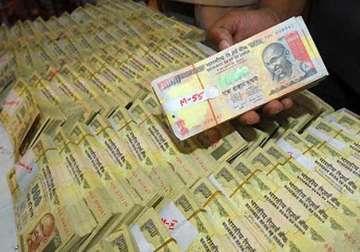Washington: India is on fourth place in terms of black money outflows with a whopping USD 51 billion siphoned out of the country per annum between 2004-2013, a US-based think-tank's report said today.
Several estimates have been given over the years on the Indian black money lying around in foreign banks. But if the latest report is to be believed, 33.6 lakh crore ($510 billion- Rs. 66 per dollar) were siphoned off in period of 10-years only.
Notably India's defence budget is less than USD 50 billion. China tops the list with USD 139 billion average outflow of illicit finances per annum, followed by Russia (USD 104 billion per annum) and Mexico (USD 52.8 billion per annum), according to the annual report released by Global Financial Integrity (GFI), a Washington-based research and advisory organisation.
The illegal capital outflows stem from tax evasion, crime, corruption and other illicit activity, the report said, according to which a record USD 1.1 trillion flowed illicitly out of developing and emerging economies in 2013, the latest year for which data is available.
In all, during this decade-long period of 2004-2014, GFI estimates that more than half a trillion (USD 510 billion) went out of India and in the case of China the figure was USD 1.39 trillion and Russia USD 1 trillion.
Titled ‘Illicit Financial Flows from Developing Countries: 2004-2013', the study shows that illicit financial flows first surpassed USD 1 trillion in 2011 and have grown to USD 1.1 trillion in 2013, marking a dramatic increase from 2004, when illicit outflows totalled just USD 465.3 billion.
China also had the largest illicit outflows of any country in 2013, amounting to a staggering USD 258.64 billion in just that one year, the report said.
“This study clearly demonstrates that illicit financial flows are the most damaging economic problem faced by the world's developing and emerging economies,” said GFI President Raymond Baker, a longtime authority on financial crime.
“This year at the UN the mantra of ‘trillions not billions' was continuously used to indicate the amount of funds needed to reach the Sustainable Development Goals. Significantly curtailing illicit flows is central to that effort,” he said.
Noting that Sustainable Development Goals (SDGs) calls on countries to significantly reduce illicit financial flows by 2030, the report said the international community has not yet agreed on goal indicators, the technical measurements to provide baselines and track progress made on underlying targets and subsequently the overall SDGs.
In its report, GFI recommends that world leaders should focus on curbing opacity in the global financial system, which facilitates these outflows.
(With inputs from PTI)
Latest Business News
